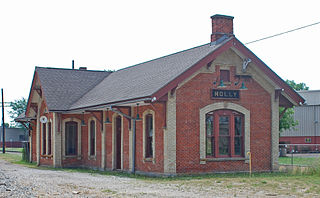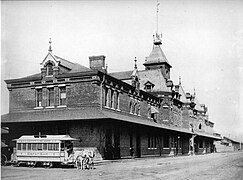The Pere Marquette Railway was a railroad that operated in the Great Lakes region of the United States and southern parts of Ontario in Canada. It had trackage in the states of Michigan, Ohio, Indiana, and the Canadian province of Ontario. Its primary connections included Buffalo; Toledo; and Chicago. The company was named after Jacques Marquette, a French Jesuit missionary who founded Michigan's first European settlement, Sault Ste Marie.

The Michigan Central Railroad was originally chartered in 1832 to establish rail service between Detroit, Michigan, and St. Joseph, Michigan. The railroad later operated in the states of Michigan, Indiana, and Illinois in the United States and the province of Ontario in Canada. After about 1867 the railroad was controlled by the New York Central Railroad, which later became part of Penn Central and then Conrail. After the 1998 Conrail breakup, Norfolk Southern Railway now owns much of the former Michigan Central trackage.
The Baltimore and Ohio Chicago Terminal Railroad is a terminal railroad in the Chicago area, formerly giving various other companies access to (Chicago's) Grand Central Station. It also served to connect those railroads for freight transfers, and is now controlled by CSX Corporation, the successor to the Baltimore and Ohio Railroad.
The Sarnia Subdivision is a railroad line owned by the Lake Erie and Detroit River Railway and operated by CSX Transportation in the Canadian province of Ontario. The line runs from Chatham north to Sarnia along a former Pere Marquette Railway line. From its north end, CSX has trackage rights west over the Canadian National Railway's Strathroy Subdivision and the Grand Trunk Western Railroad's Flint Subdivision to the CSX Port Huron Subdivision near Port Huron, Michigan, and the Saginaw Subdivision in Flint.

Holland station, also known as the Padnos Transportation Center, is an intermodal transit station in Holland, Michigan. It serves Amtrak's Pere Marquette line and is the central hub for Macatawa Area Express (MAX) buses. The facility includes a ticket machine and a waiting room.

The Vernon J. Ehlers Station is a train station in Grand Rapids, Michigan, United States served by Amtrak, the U.S. national railroad passenger system. The station is the terminus of the Pere Marquette line that connects Chicago's Union Station to Grand Rapids. It opened at its new location on Century Avenue under the Wealthy Street/US Highway 131 overpass, immediately south of The Rapid's Central Station. It is named in honor of then-Congressman Vernon J. Ehlers.

The Union Depot is a former train station, located at 637 E. Michigan Avenue in Lansing, Michigan. It was listed on the National Register of Historic Places in 1995. Despite the union name, Grand Trunk Western trains stopped at a different station in Lansing 1.5 miles away.
The Flint and Pere Marquette Railroad (F&PM) is a defunct railroad which operated in the U.S. state of Michigan between 1857 and 1899. It was one of the three companies which merged to become the Pere Marquette Railway.
The Toledo Division was the southern half of the Pere Marquette Railway's main line, which ran from Ludington, Michigan to Toledo, Ohio. The Toledo Division encompassed the portion which ran from Toledo north to Saginaw, Michigan, where it met the Ludington Division. The line was built by a predecessor of the PM, the Flint & Pere Marquette, and is currently owned by CSX Transportation.

Lake is an unincorporated community in Clare County in the U.S. state of Michigan. The community is located within Garfield Township. As an unincorporated community, Lake has no legal autonomy of its own but does have its own post office with the 48632 ZIP Code.
The Saginaw Subdivision is a railroad line in the U.S. state of Michigan. The line runs 105 miles from Toledo, Ohio, to Saginaw, Michigan. CSX owns the line although since 2006, the section from Mt. Morris to Saginaw has been leased to the Lake State Railway but is still occasionally used by CSX. The Plymouth to Mt. Morris line was also leased to LSRC starting in March 2019.
The Plymouth Subdivision is a freight railroad line in the U.S. state of Michigan. It is owned by CSX. It connects the Plymouth Diamond at milepost CH 24.5 to Grand Rapids at CH 148.1, passing through the Lansing metropolitan area en route. Other towns served include South Lyon, Brighton, Howell, Fowlerville, Williamston, Grand Ledge, Lake Odessa, Clarksville, and Alto. Operationally, it is part of the CSX Chicago Division, dispatched from Jacksonville, Florida.

The Fort Street Union Depot was a passenger train station located at the southwest corner of West Fort Street and Third Street in downtown Detroit, Michigan. It served the city from 1893 to 1971, then demolished in 1974. Today, the downtown campus of Wayne County Community College occupies the site.

The Chesapeake & Ohio Railway Station is a railway depot located in Pioneer Park on West Lake Street in Petoskey, Michigan. It was placed on the National Register of Historic Places in 1970. The building now houses the Little Traverse Historical Museum.

The Chicago and West Michigan Railroad Charlevoix Station is a railroad depot located on Chicago Avenue in Charlevoix, Michigan. It was listed in the National Register of Historic Places in 1995.

The Union Depot is a railway station located at 610 Western Avenue in Muskegon, Michigan. It was listed on the National Register of Historic Places in 2000. It is now the Muskegon County Convention & Visitor's Bureau.

The Bay City Station of the Pere Marquette Railway, also known as The Depot Building, is a former railroad depot located at 919 Boutell Place in Bay City, Michigan. It was listed on the National Register of Historic Places in 1982.

The Holly Union Depot is a former train station located at 223 South Broad Street in Holly, Michigan. It was listed on the National Register of Historic Places in 2000. It sits at the junction of tracks which are now owned by CSX Transportation and Canadian National Railway.

The Clio Depot is a former railroad depot located at 300-308 West Vienna Road in Clio, Michigan. It was listed on the National Register of Historic Places in 1983. The building has been converted into the Clio Depot and Museum.

Grand Rapids Union Station was a union station in Grand Rapids, Michigan. A Georgian Revival building of two stories, it was built in 1900 on 61 Ionia Avenue SW and was closed in 1958. The building was demolished in 1958 and 1959 to make space for the U.S. Route 131 highway.



















